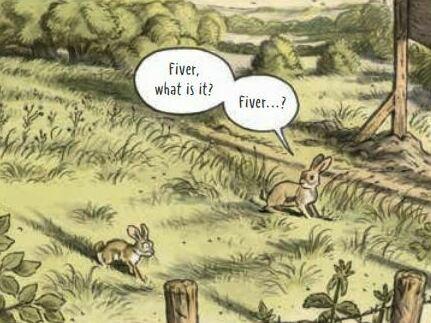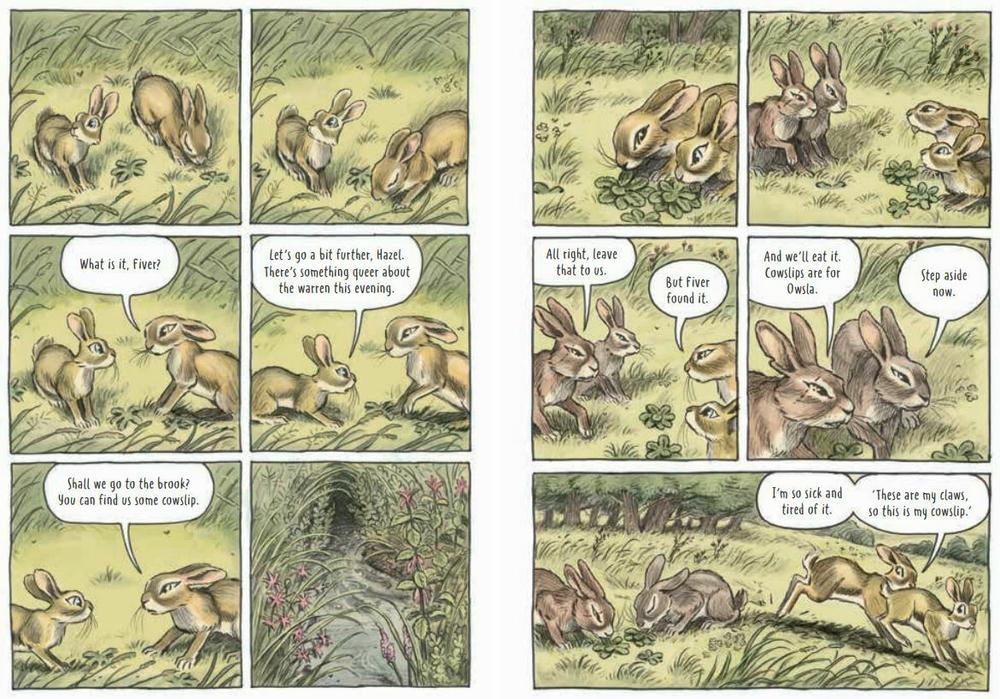Section Branding
Header Content
A new graphic novel version of 'Watership Down' aims to temper darkness with hope
Primary Content
The children's classic Watership Down began life one summer's day in the mid-1960s.
Richard Adams, an Oxford-educated civil servant, was taking his two young daughters on a drive through the British countryside. They wanted to be entertained, and he complied.
"He started off a story, 'Once upon a time there were two rabbits, called Hazel and Fiver,' " recalls the younger one, Rosamond Mahony, who was about 6 at the time.
Fiver has a premonition that their warren is doomed. His brother Hazel plans their escape.
Drawing upon his knowledge of Greek tragedy and the English countryside where he grew up, Adams spun a tale of a group of rabbits who leave their warren and undertake a dangerous journey in search of safety.
"He made it up as he went along," Mahony explains. "But when we got there, the story was so long that he hadn't actually finished it. So it had to be finished on the way to school on subsequent mornings."
Ever since, Watership Down has teetered on the cusp between children's fantasy and adult literature. The appearance this month of a graphic novel — a genre that itself appeals to both young and old — only deepens that discussion of who the story is for, and whether children's books were ever meant exclusively for children in the first place.
"He just said it was a book that was written for anybody who wanted to read it, and that was anybody from those who were so small they could hardly hold the book, to those who were so old that they could hardly see the print," Mahony says.
A story about the lives of rabbits turns out to have many layers
Adams treated his children, if not exactly as adults, then as something more like peers. He took them to operas and read them Shakespeare. (In fact, that summer drive was to see a play by the Royal Shakespeare Company in Stratford-upon-Avon.) And he exploited for their benefit his huge imagination, that, according to Mahony, went underutilized as a member of the country's vast bureaucracy.
Her older sister, Juliet Johnson, says sometimes, however, their father could be simply exhausting.
"There was always noise and shouting. And, you know, he could talk about things till the cows came home," she says.
After their father finally finished telling that story, the girls encouraged him to write it down. Eventually he did, elaborating as he went — and consulting his daughters regularly. By that point, Johnson was away at boarding school.
"Somewhere in a tin around here I have a box of letters where he'd get stuck on things," Johnson remembers. "He'll sort of say, 'I haven't decided whether to let Bigwig die in the snare or not yet.' Or, you know, 'I've got to think of some more jokes for Bluebell.' "
Several publishers rejected the manuscript, saying it was too long for children (about 500 pages in book form) and that adults would not want to read a story about rabbits.
Adams disagreed, and in 1972, when Watership Down was finally published, he was proven right. People still couldn't decide if it was a kid's book or not, but it was read by all ages.
"It turned out the lives of those rabbits were so much more interesting than I could have imagined," says children's book author SF Said, who encountered the book when he was 8 — after his mother had read it.
"They were living in a very dark and dangerous world, and everything out there seemed to be bigger than them, stronger than them. I could not stop turning the pages. I had to know how were they going to do it? How are they going to live?"
Said, whose new book, Tyger, won the 2023 British Book Award for best children's fiction, counts Watership Down as his favorite book ever. He says he uncovers another layer every time he reads the book: It's about nature, mythology, political philosophy and overcoming prejudice.
"There's this huge, ferocious seabird called Kehaar, who the rabbits are terrified of," Said explains. "But Hazel, the leader, befriends Kehaar because he sees, first of all, this bird is in trouble and needs help. Secondly, this bird could be a phenomenal ally if they could only befriend him."
The G rating on a 1978 film adaptation gets reconsidered
Yet even though the book has sold more than 50 million copies worldwide, the 1978 animated film version probably made an even larger impression on the public, at least for people now in their 40s and 50s, as a terribly dark story.
The film was rated G but famously scared a lot of the unsuspecting kids who saw it. In fact, just in this past year, it was re-classified as PG.
The film's director, Martin Rosen, said in a recent interview with NPR that he wasn't trying to make a film for adults, nor for children. He was making a movie for himself.
"I felt it would be dishonest not to make the picture as I perceived it when I read it," he explained. "That's what he wrote. It was bloody. And I felt honor-bound to represent it as such."
And he's got a point. Richard Adams fought in World War II. Glimpses of his wartime experiences emerge throughout the book. The rabbit Hazel was based on the author's commanding officer. And there's a lot of fighting and fear of death.
Adams died in 2016. By that point, the book had also been adapted for the stage, radio, television and Netflix. A few years ago, the daughters decided a graphic novel version would reach a new audience. They were looking for a team that would stay close to the text, and chose storyboard artist James Sturm, the co-founder of the Center for Cartoon Studies in Vermont, and best-selling illustrator Joe Sutphin, based in Ohio.
Focusing less on the peril and more on the hope
One of the first things the two Americans did was fly to London, meet with Mahony and Johnson, and visit the real Watership Down — a gentle hill in southern England.
"I wasn't aware of that, that every location in the book was an actual place," Sturm says. "We took hundreds of photos and videos. I remember crawling on my hands and knees trying to get a shot, like how the rabbits might see it."
Sutphin spent a great deal of time at a wildlife center in Ohio, observing rabbits close up. His drawings of the animals are more realistic than the ones in the screen version — the eyes narrower, the bodies leaner.
"I was trying not to be too exaggerated or fantastical," Sutphin says. "So I knew that Ros and Juliet didn't want like a Bugs Bunny kind of thing happening."
With the input from Adams' daughters, the graphic novel team tried to provide a more tempered interpretation than the one portrayed in the 1978 movie.
"I hope that this book will help people correct their memory of Watership Down. The animated film focused heavily on the peril and less on the beauty," Sutphin explains. "The way that we tell it, the darkness is real. But, it's all with that sense that you're holding on to faith, you're building character, you're finding hope."
Copyright 2023 NPR. To see more, visit https://www.npr.org.


